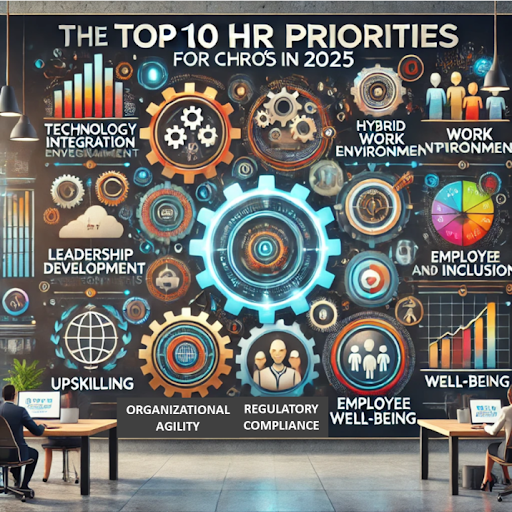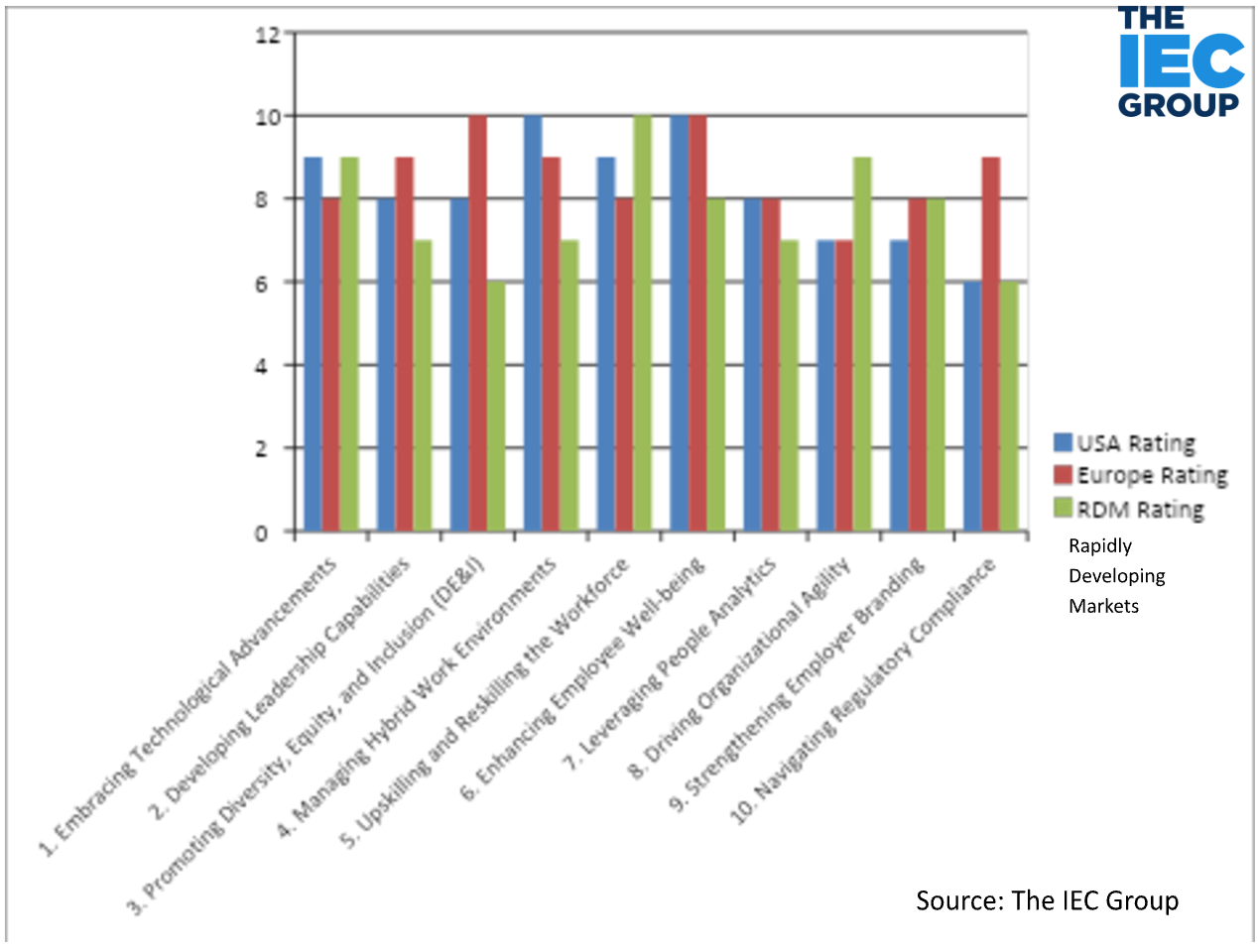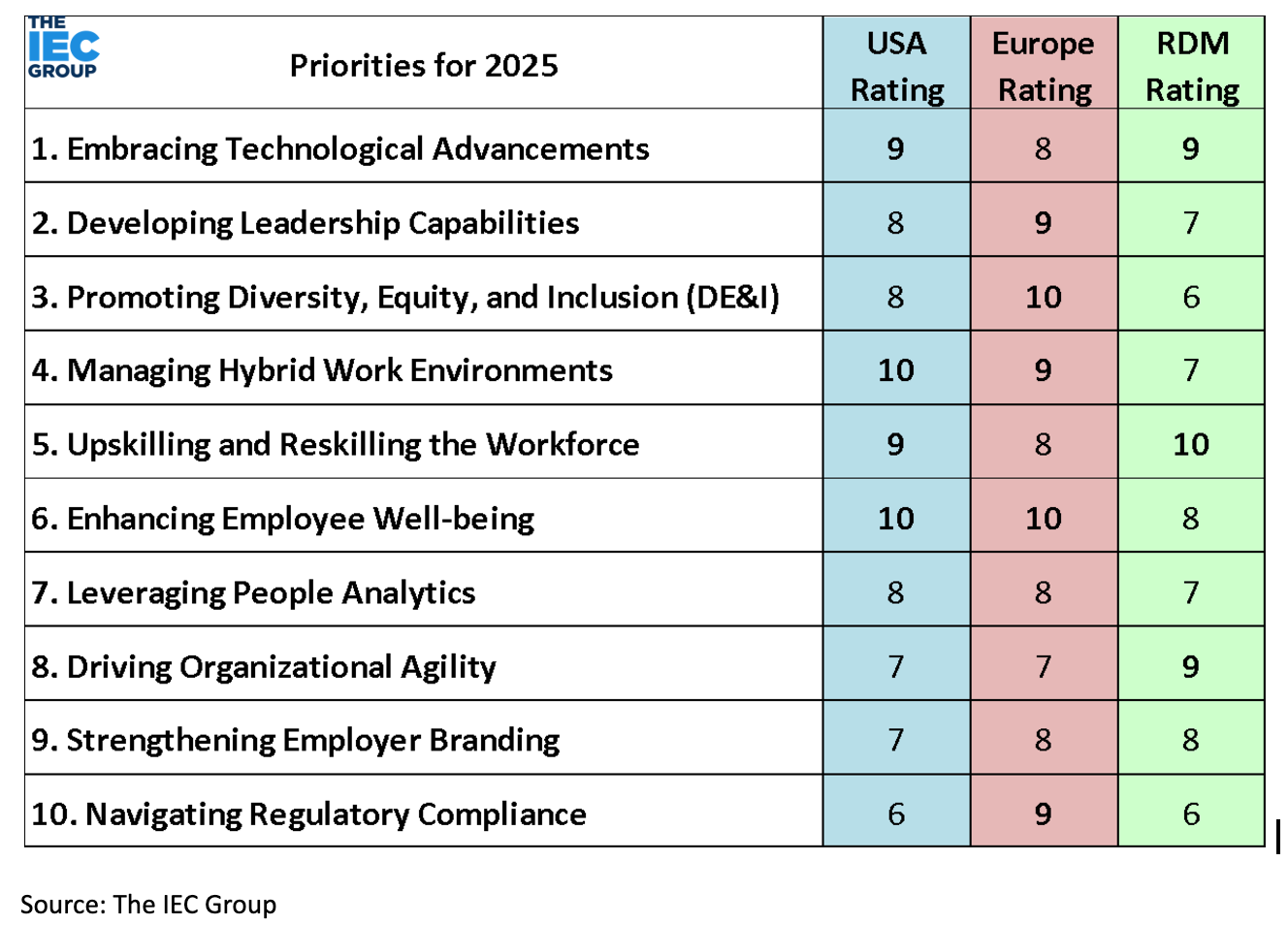Top 10 Priorities for CHROs in 2025: Navigating Change and Shaping the Future Workforce
2025 CHRO Playbook: The Top 10 Priorities Redefining HR
 As 2025 approaches, CHROs face a dynamic landscape demanding agility, tech-savvy leadership, and a renewed focus on workforce well-being. Top of the list? Managing hybrid work and embracing technology to stay competitive in a rapidly evolving world. In the U.S., priorities center on flexibility and mental health as employees continue to demand more from their workplaces. Europe, with its strict regulations, emphasizes DE&I and compliance. Meanwhile, in rapidly developing markets, it’s all about upskilling and organizational agility, crucial for keeping pace with fast-growing industries.
As 2025 approaches, CHROs face a dynamic landscape demanding agility, tech-savvy leadership, and a renewed focus on workforce well-being. Top of the list? Managing hybrid work and embracing technology to stay competitive in a rapidly evolving world. In the U.S., priorities center on flexibility and mental health as employees continue to demand more from their workplaces. Europe, with its strict regulations, emphasizes DE&I and compliance. Meanwhile, in rapidly developing markets, it’s all about upskilling and organizational agility, crucial for keeping pace with fast-growing industries.
Tech adoption remains a global imperative, empowering HR to harness predictive analytics for smarter, more strategic decisions. Employee well-being, however, is universal: physical, mental, and emotional health are no longer perks but essentials. And, as the talent race intensifies, a strong employer brand has never been more critical. These 10 priorities underscore a shift in HR’s role—no longer just supporting business but driving it. With these focus areas in place, CHROs are set to lead a transformative agenda, balancing technological advancement with an unwavering commitment to people-centered leadership. 2025 will be the year HR stops keeping up and starts setting the pace.
Introduction
As Chief Human Resource Officers (CHROs) look toward 2025, they face a complex landscape shaped by rapid technological advances, shifting workforce expectations, and a growing emphasis on inclusion and agility. Below is an overview of the top 10 priorities CHROs should focus on to address these challenges and lead their organizations successfully into the future.
- Embracing Technological Advancements
With technology playing an increasingly pivotal role in HR, CHROs are prioritizing the adoption of AI, analytics, and other digital tools to streamline HR functions and enhance employee experiences. By integrating these technologies, HR leaders can improve efficiency and make data-driven decisions that align with broader business strategies.
Actions:
- Implement AI tools in talent acquisition and employee engagement processes to streamline hiring and personalize employee experiences.
- Invest in predictive analytics platforms to anticipate trends such as attrition risks and skill gaps, allowing HR to act proactively.
- Developing Leadership Capabilities
Today’s leaders are expected to be empathetic, inclusive, and adaptable. Developing leadership capabilities that align with these expectations is crucial for fostering a positive organizational culture and preparing managers to lead in a rapidly evolving workplace.
Actions:
- Create targeted leadership development programs focused on empathy, inclusiveness, and resilience.
- Establish mentorship and coaching networks to support continuous leadership growth and facilitate peer-to-peer learning.
- Promoting Diversity, Equity, and Inclusion (DE&I)
Building diverse teams, ensuring equitable practices, and fostering an inclusive culture have become non-negotiable for CHROs. These efforts not only reflect societal expectations but also improve engagement and innovation within the organization.
Actions:
- Set measurable DE&I goals linked to performance reviews and incentives to drive accountability at all levels.
- Develop DE&I training sessions and workshops that address unconscious bias and promote respect across the organization.
- Managing Hybrid Work Environments
With hybrid work becoming the norm, CHROs are focused on creating policies that balance flexibility with productivity. This involves developing clear guidelines, investing in collaborative technology, and ensuring that hybrid teams remain engaged and connected.
Actions:
- Establish hybrid work policies that outline expectations, support resources, and communication standards for both remote and in-office employees.
- Invest in collaborative technology to enhance productivity and connectivity within hybrid teams.
- Upskilling and Reskilling the Workforce
As industries evolve, so do the skills required for success. Upskilling and reskilling initiatives are essential for ensuring that employees have the capabilities needed to stay competitive, particularly as automation and AI reshape job roles.
Actions:
- Launch a continuous learning program with access to courses and certifications aligned with future skill requirements.
- Partner with educational institutions or online platforms to provide reskilling opportunities for emerging skills.
- Enhancing Employee Well-being
Employee well-being has become a central concern, as it directly impacts engagement, productivity, and retention. CHROs are focused on creating initiatives that support physical, mental, and emotional health, recognizing the integral role of well-being in sustaining a healthy work environment.
Actions:
- Implement wellness initiatives such as mental health days, counseling services, and flexible work hours to support work-life balance.
- Create a well-being dashboard to track indicators like burnout and satisfaction, enabling timely interventions.
- Leveraging People Analytics
People analytics empowers HR teams to make data-driven decisions across hiring, development, and retention strategies. CHROs are prioritizing the adoption of analytics platforms that provide insights into workforce dynamics, helping align HR initiatives with business goals.
Actions:
- Adopt a centralized HR analytics platform to aggregate and analyze employee data, enhancing decision-making.
- Train HR teams on data interpretation to empower them to leverage analytics effectively in strategic planning.
- Driving Organizational Agility
The ability to adapt quickly to market changes has become crucial. By fostering organizational agility, CHROs can create structures and processes that support flexible, fast-paced decision-making, ensuring the company remains competitive and resilient.
Actions:
- Encourage cross-functional teams and agile project structures to improve responsiveness and streamline decision-making.
- Embed agility into performance metrics by setting goals related to adaptability and continuous improvement.
- Strengthening Employer Branding
Employer branding is essential for attracting and retaining top talent. As competition for skilled employees intensifies, CHROs are focused on building strong employer brands that highlight the organization’s values, culture, and commitment to employee growth.
Actions:
- Promote employee testimonials and success stories to build an authentic employer brand.
- Develop a social media strategy for recruitment that showcases the company’s commitment to inclusivity, growth, and employee development.
- Navigating Regulatory Compliance
Staying compliant with evolving labor laws and regulations remains a core responsibility, especially in regions with complex labor requirements. CHROs must keep up with regulatory changes to avoid legal risks and ensure fair practices.
Actions:
- Establish a compliance monitoring system to track changes in labor laws across different regions, ensuring policies are updated promptly.
- Conduct regular training sessions on compliance for HR and management teams to reinforce awareness and mitigate risks.
Conclusion
These top 10 priorities reflect the evolving responsibilities of CHROs as they prepare for 2025. Managing hybrid work, advancing technological adoption, promoting DE&I, and prioritizing employee well-being are just a few of the focus areas that will define HR’s strategic role in shaping the future workforce. By implementing these actionable steps, CHROs can lead their organizations in building a resilient, agile, and engaged workforce that thrives in an ever-changing business environment.
Prioritization from 1 to 10
The sequence in the priority list from 1-10 is based on the anticipated impact and urgency of each priority on the overall HR strategy for 2025. Here’s how each factor was considered in determining the order:
- Direct Impact on Workforce Management: Priorities like managing hybrid work environments and enhancing employee well-being were rated higher as they have an immediate effect on employee satisfaction, retention, and productivity, which are critical for business continuity.
- Strategic Importance: Topics such as embracing technological advancements and upskilling/reskilling are pivotal for future-readiness, enabling HR departments to be proactive and strategic rather than merely operational.
- Relevance to Current Trends and Challenges: Issues like employee well-being and DE&I were prioritized because they address pressing societal expectations and global trends, making them essential for sustaining organizational reputation and aligning with modern values.
- Global vs. Regional Considerations: The ranking reflects challenges that are universally significant (like hybrid work and technology adoption) but acknowledges that some priorities, such as regulatory compliance, may vary in urgency depending on the region.
- Long-Term Business Impact: Priorities such as organizational agility and leadership development are essential for long-term adaptability and competitiveness, even if their direct impact may unfold over a longer horizon compared to more immediate needs.
This approach creates a balanced sequence where the highest priorities reflect the pressing challenges that HR leaders need to address immediately, while still considering the strategic and enduring factors critical for sustainable growth and resilience.
Regional Observations with Importance Rating from 1 to 10:
These ratings highlight that CHROs place particular importance on managing hybrid work, employee well-being, and technology integration, as these areas have a direct and immediate impact on employee experience and organizational resilience.
- USA: High priority is given to managing hybrid work and enhancing employee well-being, reflecting the growing emphasis on flexible work models and mental health. Technological advancements and upskilling are also valued to keep up with innovation.
- Europe: DE&I and well-being are especially important, aligning with Europe’s strong focus on equitable practices and strict labor regulations. Regulatory compliance is rated higher due to complex labor laws.
Rapidly Developing Markets (RDM): Upskilling and organizational agility are prioritized to support growth and competitiveness. While technology and employer branding remain important, hybrid work and DE&I receive slightly lower ratings, reflecting different regional norms and workforce dynamics.


CHRO Go To’s: After Reading the 2025 Playbook: Align, Compare, and Strategize
After reviewing the top 10 CHRO priorities for 2025, the next steps for a CHRO should focus on aligning, comparing, and strategically positioning their HR agenda with the broader business landscape. Here’s how:
- Compare Current Priorities with the Top 10 List
- Assessment: Start by listing your current HR priorities and rating them based on their perceived importance to the organization.
- Identify Gaps: Compare these with the top 10 list provided. Are there critical areas like technology adoption, employee well-being, or hybrid work that are missing or undervalued in your current strategy?
- Evaluate Differences: Determine why certain areas might have been overlooked. Is it due to regional specifics, organizational culture, or a lack of resources? Understanding these reasons can guide necessary adjustments.
- Check for Additional Priorities Beyond the List
- Unique Challenges: Every organization has unique challenges that might not be fully captured in a general list. Consider if there are industry-specific, cultural, or strategic priorities that need to be added.
- Innovation Opportunities: Are there emerging trends or innovative practices within your industry that haven’t made it to the top 10? Including these can set your organization apart.
- Align Priorities with Business Strategy and Urgency
- Business Objectives: Cross-reference each HR priority with the company’s short-term and long-term business goals. How do initiatives like upskilling, DE&I, or leadership development directly contribute to these objectives?
- Urgency and Impact: Rank priorities not just by their overall importance, but by their urgency. For example, if the business is rapidly expanding into new markets, upskilling and agility might take precedence.
- Strategic Conversations: Engage with other C-suite leaders to understand their perspectives and how HR can support their departmental goals. This collaboration ensures HR initiatives are strategically aligned across the organization.
- Evaluate Budget and Resources
- Resource Allocation: Determine if the budget reflects the importance of each priority. For instance, if technology adoption and people analytics are top priorities, is there adequate investment to support these initiatives?
- Reallocate or Justify: If there’s a misalignment, consider reallocating resources from less critical areas or building a case to justify increased funding. Demonstrating how each priority aligns with business outcomes can strengthen budget discussions.
- Assess Talent and Capability Needs
- Skills Inventory: Conduct an inventory of the HR team’s skills to determine if you have the necessary expertise to drive each priority effectively. For example, does the team have strong analytics and technology skills to manage the growing importance of people analytics?
- Training and Development: If there are gaps, consider investing in upskilling the HR team itself. For instance, developing expertise in hybrid work management, leadership coaching, or DE&I can strengthen the team’s ability to implement each priority successfully.
Conclusion
Aligning HR’s 2025 priorities with the broader business strategy, budget, and organizational needs is critical. By comparing existing priorities with the top 10 list, identifying unique needs, and cross-referencing with business objectives, CHROs can strategically position HR as a driver of organizational success. Ensuring that resources and talent are aligned with these goals will enable HR to meet evolving employee expectations, support the business’s competitive edge, and enhance organizational agility. The result? An HR function that’s not only responsive but also a key contributor to strategic growth and innovation in 2025.
Last but not Least: If you’re facing challenges and wondering how others are managing similar issues, why not join The Leadership Collective Community? It’s a peer group and webcast platform designed for leaders to exchange insights and experiences.
Introducing the IEC Knowledge Network Free Membership – Your Gateway to Seamless Access!
We are thrilled to present a new service that goes beyond the ordinary download experience. In addition to offering you the ability to download the things you love, we are delighted to introduce the IEC Knowledge Network Free Membership.
The Free Membership option grants you access to our library of articles and videos, without the need for tedious registrations for each piece of content.
The publication serves as a trusted resource to support executives in their pursuit of sustainable and successful global expansion. In addition the IEC Practitioners are available to discuss your specific challenge in more detail and to give you clear advise..
Take advantage of this valuable resource to accelerate your global expansion journey


